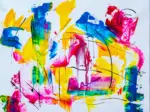What is an “artist”? When the word comes to mind, you may think of someone who practices for years to hone their craft, someone who’s naturally artistically gifted or the greats like Monet and Picasso. While those examples do all fall under the definition, they don’t make up the entirety of it. Simply put, an artist is just someone who makes art — just like how a singer sings and a teacher teaches.
Art is one the most beautiful and intimate ways humans can express themselves. When people hear the word, they may typically only picture painting and drawing, but art is any creative activity, like decorating a cake, writing a short story or dancing.
https://www.instagram.com/p/B-bmpfsjlE8/?utm_source=ig_web_copy_link
The amazing thing about it is that you don’t need to be a modern-day Michelangelo to take part in it. You just have to be you. Trying your hand at something creative is not only a fun way to pass the time, it’s also good for you.
Self-Esteem Booster
When you were younger, your parents may have stuck your latest stick figure drawing that you did in class on the fridge. It gave you that sense of “Wow, I did it!” — it was a huge ego boost to know that someone was proud of you. Although you may no longer get your fridge moment, you can still get that same feeling.
Positive accomplishments like finishing that scarf you were knitting or putting the final touch on that painting releases dopamine into your brain. Dopamine increases your focus and motivation, wards off sadness and stimulates the creation of new neurons that keep the brain active.
Framing your work, photographing it and sending it to your friends, recording it and sharing it on social media — these can all provide a great sense of accomplishment, which will in turn increase your self-esteem. Who doesn’t like to feel like they achieved success?
Stress Slayer
Living a stressful life is unfortunately something that’s extremely common these days. There’s this constant air of anxiety in the world; it seems like there’s always something to worry about. This can get you down both physically and mentally. Stress can cause headaches, digestive and sleep problems, as well as change the entire structure of your brain and shrink it. Chronic stress can even increase the risk of mental illness.
Art is an easy way to relieve tension. Creating it requires you to be in the moment, to focus on what you’re doing and only on what you’re doing. This is a nice change of pace from thoughts running a mile a minute.
A study from Art Therapy found that after only 45 minutes of art making, the cortisol levels in the saliva of the participants had gone down. In their written responses about the experience, the participants reported that they found the session to be freeing and relaxing, and also indicated that they would like to create more art in the future.
Immersing yourself in any form of creativity can provide a much-needed break from the horrors of the world, even if it’s only for a little bit.
Brain Stimulator
The more you practice and learn an art form, the more engaged your brain becomes. You may gain creative ability from art, but that doesn’t mean you only have to use it for art. The process of creating allows you to think on your feet since there are no hard guidelines you need to follow. This skill can help you in the workplace, at school, at home — basically anywhere.
Making art can also create new connections between brain cells. Every time our mind takes part in a new or complex activity, it grows. The brain’s ability to develop connections and change throughout its lifetime is called neuroplasticity, and without it, humans wouldn’t be able to evolve from infancy to adulthood, or recover from brain injuries. Neural connections that are no longer useful are gotten rid of, while the necessary ones are strengthened. Doing something as simple as doodling in a sketchbook can help train your brain.
Problem Solver
There are no hard and fast rules to art. Once you know a few basics, you can do whatever you want, and no one can tell you otherwise. Art encourages open-ended thinking, and, as touched on before, provides you with the ability to think on your feet. You can find new, interesting ways to solve problems.
A study conducted by the Guggenheim Museum, entitled “The Art of Problem Solving,” showed that children with an art background had a significant advantage over their peers, demonstrating strong problem solving skills. Researchers found that problem solving was incorporated into students’ daily art lessons.
If you really stop and think about it, all art is born from a problem, the problem typically being how to convey a certain idea or emotion through your work. For example, a writer has to plan how they will evolve a story and its characters; an actor has to figure out how they’ll use their facial expressions and tone to flesh out their role. By practicing critical thinking when you are creating, you’ll gain a lifetime skill.
Life Changer
Art has the ability to not only bring happiness to you, but to others as well. It doesn’t matter if you share it online for thousands to see, only show your parents or if someone, many years down the road, comes across your masterpiece by accident — someone will be affected by it.
You’ve most likely experienced this yourself. Maybe there’s been a painting at a museum that took your breath away, or a book you’ve read that’s changed your life. The creator may not ever know who you are, or how they impacted you, but by you viewing their art, they’ve made a connection with you, and at the end of the day, that’s what it’s all about.
Art is made for an endless amount of reasons, including the ones listed here, and experiencing and creating it can be a very individual experience, but it always serves to connect the artist with the viewers — whether it’s connecting you with another, or connecting you with parts of yourself you didn’t yet know existed. So, don’t be afraid to set your inner artist free.


















Comparing artists to singers or teachers makes this concept much more familiar and easier to understand.
Comparing artists to singers or teachers makes this concept much more familiar Geometry Dash and easier to understand.
ád sa dsad ád sadad á đa đa sadad ada adsa dád á